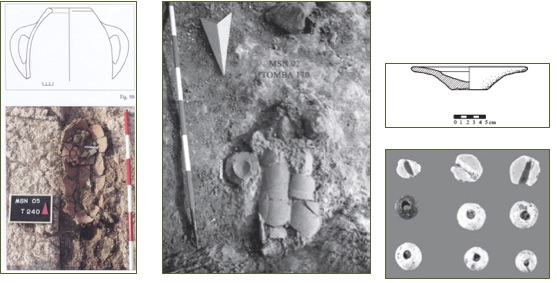Enchytrismos tomb items
There are several enchytrismòs burials in Monte Sirai, i.e. The burial procedure in which the dead person is placed inside a large urn, in our case a commercial amphora (figs. 1-2). Burial in an amphora, reserved for babies or children, is well documented as a secondary placement for ashes from a previous ceremony. Chronology of this use is just before 500 to 300 B.C.


Figs. 1-2 - Burials in amphorae in tombs 59 (BARTOLONI 2004, fig. 42) and tomb 16 (PIGA et al. 2008, fig. 3).
The use of a collection of items that accompanied the dead person was not widespread: in addition to ceramic items such as plates, there are some ornamental items, items to ward off evil and necklaces, sometimes inside the amphora itself (figs. 3-5). The protective amulets are Egyptian style.

Figs. 3-5 - Tomb 240, with the internal items (GUIRGUIS 2010, figs. 98-99); tomb 170 and items inside (BOTTO, SALVADEI 2005, figs. 23-25).
Bibliografia
- P. BARTOLONI, La necropoli di Monte Sirai - I (Collezione di Studi Fenici, 41), Roma.
- P. BARTOLONI, Monte Sirai, Sassari.
- M. BOTTO, L. SALVADEI, Indagini alla necropoli arcaica di Monte Sirai. Relazione preliminare sulla campagna di scavi del 2002, in RStudFen, 33, pp. 81-167.
- G. PIGA et alii, A Funerary Rite Study of the Phoenician–Punic Necropolis of Mount Sirai (Sardinia, Italy), in Int. J. Osteoarchaeol.
- M. GUIRGUIS, Necropoli fenicia e punica di Monte Sirai. Indagini archeologiche 2005-2007 (Studi di Storia Antica e di Archeologia, 7), Ortacesus 2010.

 VR
VR